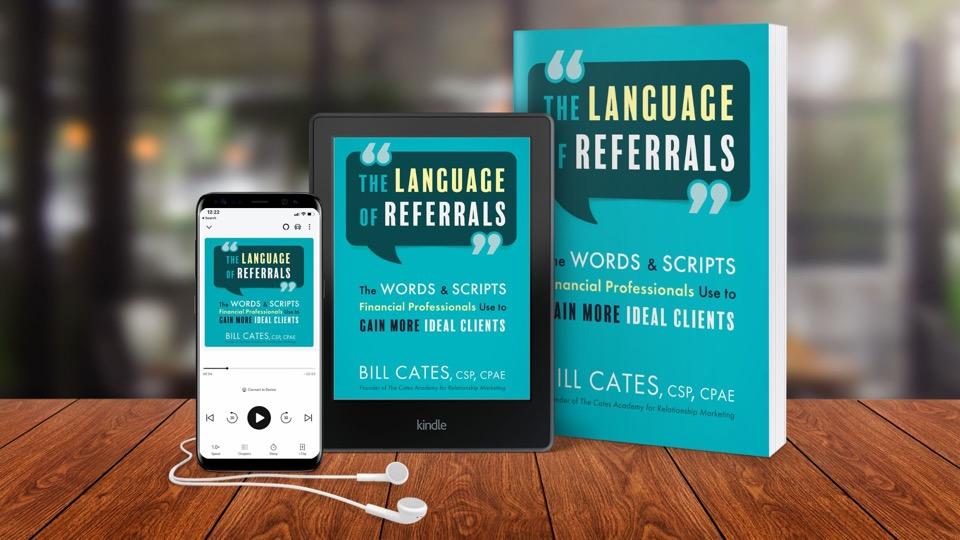
7 minute read
The Language of Referrals
By Bill Cates
In The Language of Referrals, Bill Cates, CSP CPAE, offers his newest insights on an essential yet consistently avoided strategy in business networking: referrals and introductions. He offers in-depth guidance to achieve the confidence and fluency needed to effectively gain referrals and introductions.
Q: So, Bill… Another book about referrals and introductions? Why did you write The Language of Referrals? What’s in this book that isn’t in the others?
I wrote The Language of Referrals for two main reasons.
First, a few things have changed over the years related to referrals and I wanted to address those. For example, securing an effective introduction to the new prospect has become more important than ever before. This is a place where the process often breaks down. You can have a client or center of influence mention you to someone or intend to create a connection, but it never happens. Whether you ask for referrals, or they come to you unsolicited, the conversation is not complete until you have secured a relevant and compelling introduction.
Second, most financial professionals don’t have a well-defined process for generating more referrals and introductions. I wanted to lay out a complete process that an advisor or broker could adopt and then adapt to their own situation – so it becomes natural to them and produces the intended results.
Q: I believe you have divided The Language of Referrals into 6 Parts. Maybe you can give us a quick overview of each part and then we can dive a little deeper. [Inner Language, Referable, Promoting, Asking, Objections, Introductions.]
Yes. Each part represents a specific strategy and corresponding tactics that will produce more new clients through referrals and personal introductions.
PART 1: Develop the Right Inner Script –Identify and Remove Limiting Beliefs and Mistaken Assumptions
When it comes to establishing the processes and habits necessary to become proficient in generating quality introductions, most financial professionals operate from limiting beliefs and mistaken assumptions that compromise their results. It’s time to remove any counterproductive self-talk and perspectives and replace them with the inner language of more expansive thinking that will let you bring your value to those who need your guidance. This will, in turn, help you build a successful business.
PART 2: Become Super Referable –Maximize Client Engagement to Get More Unsolicited Referrals and Introductions
As you consider implementing strategies and tactics designed to generate more introductions to quality prospects, you need to ensure you are as referable as possible. Becoming super referable requires creating more engaged clients – clients who feel good about your value and who like and trust you. Learn the language of becoming super referable in the eyes of your prospects, clients, and centers of influence.
PART 3: Promote Introductions - Plant Seeds and Trigger Spontaneous Referrals without Asking
Promoting introductions allows you to present the concept of referrals and introductions quickly in a new relationship while you build a productive culture of personal introductions over time. Learn the language of promoting introductions to create spontaneous opportunities.
PART 4: Ask for Introductions - Be Proactive without Pushing, Begging, or Feeling Creepy
Yes, there is a way to ask for introductions without looking like “That Creepy Referral Guy.” It’s not rocket science. It’s about learning a proven process and gaining the confidence to consistently use that process to produce results. Learn the language of asking for introductions to make your conversations natural, authentic, and effective.
PART 5: Navigate Concerns & Objections – Explore, Understand, and Reframe
When you use the processes and language in this book, you won’t encounter much reluctance or outright resistance. With that said, knowing how to converse with your clients who are reluctant to make introductions – in a non-aggressive and professional manner – will boost your confidence and results. Learn the language of exploring, understanding, and reframing referral reluctance.
PART 6: Secure an Effective Introduction –Get Connected with Compelling Relevance
This is where many financial and insurance professionals get stuck and see their results fall short. Having clients who are willing to refer is not the same as having clients working with you to create effective introductions. Your process is not complete until you get connected to your new prospect. Learning the language will help turn a willingness to refer into solid connections with prospects waiting to hear from you.
Q: Not all advisory clients like to participate in the referral/introduction process. What are some of those reasons and how can The Language of Referrals mitigate some of that resistance?
There are two primary reasons many clients resist participating in this process. First, they are concerned about confidentiality. They don’t want others to know anything about their personal situation. Second, if you’ve not explained to your clients how you handle introduction, then this unknown can feel risky to some.
In Part 3 of The Language of Referrals, I provide easy-to-use language to mitigate these two prevalent concerns. The bottom line is that you want to teach your clients that if (or when) they think of someone who should know about the important work that you do, everything will be in strict confidence, and that you will work with them to create an introduction where everyone feels comfortable at every step along the way.
Q: In your book, The Language of Referrals, you provide a formula for how advisors can talk to their clients who are reluctant to discuss possible introductions. Can you share that formula quickly?
This process of being proactive for introductions should never be viewed – by any of the parties – as a “push.” We are not trying to push anyone into anything that doesn’t feel comfortable to them. IN the book, I demonstrate a soft but effective approach to dealing with the occasional resistance than might arise in a request for potential introductions.
The most important part of the formula – that you can use in all parts of your personal and business life – is to explore to understand reluctance. When a client is uncertain about this conversation, your instinct should be to try to understand their position – softly!!!!
Three super-effective words to use here are, “Tell me more.” If someone says, “I don’t like to give referrals.” Your response can be, “I appreciate that. I know that not everyone is comfortable with this process. Can you tell me more? Have you had a bad experience with this sort of thing?”
Sometimes you can reframe their thinking by letting them know they can contact their friends or colleagues first and that you will be very soft in your approach. And sometimes you’ll just need to back off with grace and professionalism by saying something like, “I totally understand. I just wanted you to know that I’m never too busy to see if I can serve as a resource for anyone you think should at least know about the work I do.” No harm! No foul! And you’ve planted the seed for possible results in the future.
Q: Before we conclude. How can our listeners learn more about your new book and all the other tools you provide financial professionals?
You can learn more about The Language of Referrals by going to either www.LanguageofReferrals.com or just looking it up on Amazon.com. And once you receive the book, you’ll see how to register the book to then gain access to a treasure trove of additional resources at The Language of Referrals Toolkit. Additionally, we have other complimentary guides, videos, and checklists at: www.ReferralCoach.com/resources.
While these assets are free to you, I think you’ll find them quite valuable.

Nobody understands and teaches the referral process better than Bill Cates. Bill has helped large companies cut hundreds of thousands of dollars in marketing expenses. And Bill has helped over 200,000 small business owners and salespeople build thriving referral-based businesses.
Bill's newest book, Radical Relevance, will help you sharpen your marketing message, cut through the noise, and win more ideal clients.
Bill’s referral system has been featured in such publications as Success Magazine, Entrepreneur Magazine, and Selling Power. And his own business success has been featured in Money Magazine.










